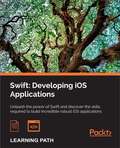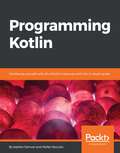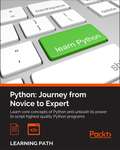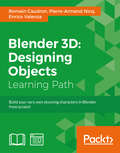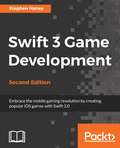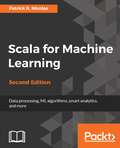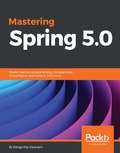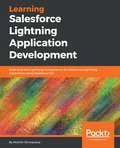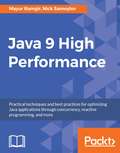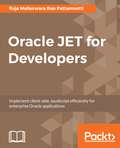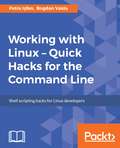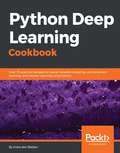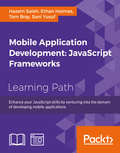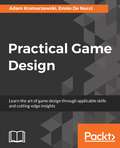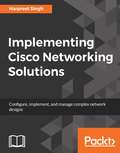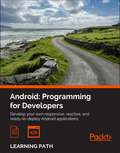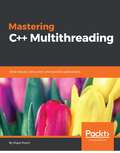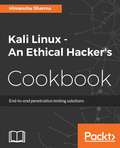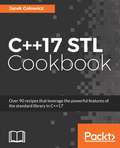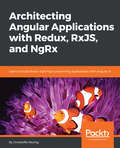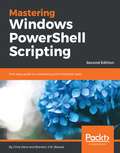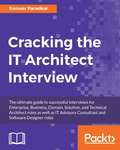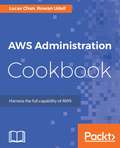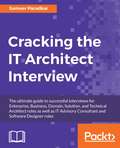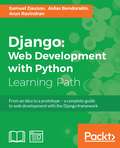- Table View
- List View
Swift: Developing iOS Applications
by Jon Hoffman Giordano Scalzo Andrew J WagnerUnleash the power of Swift and discover the skills required to build incredible robust iOS applications About This Book * Write expressive, understandable, and maintainable Swift 2 code with this hands-on course * Unveil the complex underpinnings of Swift to turn your app ideas into reality * Specialize in developing real iOS apps, and 2D and 3D video games using Swift and Cocoapods * Dive deep into protocol extensions, learn new error handling model and use featured Swift design patterns to write more efficient code Who This Book Is For This course would be for app developers who are new to developing for iOS or OSX and are trying to get grips with Swift for the first time. What You Will Learn * From a solid understanding of the Swift 2 language * Get to know the practical aspects of how a computer program actually works * Understand the paradigms used by Apple's frameworks, so you are not intimidated by them * Create a server in Swift to deliver JSON data to an iOS app * Take advantage of Cocoapods to use third-party libraries * Build games with SpriteKit and SceneKit * Develop an app running on the cloud to act as an API server for your client's apps * Dive into the core components of Swift 2 including operators, collections, control flow, and functions * Create and use classes, structures, and enums including object-oriented topics such as inheritance, protocols, and extensions * Develop a practical understanding of subscripts, optionals, and closures * Master Objective-C interoperability with mix and match * Access network resources using Swift * Implement various standard design patterns in the Swift language In Detail The Swift--Developing iOS Applications course will take you on a journey to become an efficient iOS and OS X developer, with the latest trending topic in town. Right from the basics to the advanced level topics, this course would cover everything in detail. We'll embark our journey by dividing the learning path into four modules. Each of these modules are a mini course in their own right; and as you complete each one, you'll gain key skills and be ready for the material in the next module. The first module is like a step-by-step guide to programming in Swift 2. Each topic is separated into compressible sections that are full of practical examples and easy-to-understand explanations. Each section builds on the previous topics, so you can develop a proficient and comprehensive understanding of app development in Swift 2. By the end of this module, you'll have a basic understanding of Swift 2 and its functionalities. The second module will be the an easy-to-follow guide filled with tutorials to show you how to build real-world apps. The difficulty and complexity level increases chapter by chapter. Each chapter is dedicated to build a new app, beginning from a basic and unstyled app through to a full 3D game. The last two chapters show you how to build a complete client-server e-commerce app right from scratch. You'll be able to build well-designed apps, effectively use AutoLayout, develop videogames, and build server apps. The third and the last module of our course will take an example-based approach where each concept covered is supported by example code to not only give you a good understanding of the concept, but also to demonstrate how to properly implement it. Style and approach This course includes all the resources that will help you jump into the app development .This course covers all the important aspects Swift application development and is divided into individual modules so that you develop your skill after the completion of a module and get ready for the next. Through this comprehensive course, you'll learn how to use Swift programming with hands-on examples from scratch to finish!
Programming Kotlin
by Stefan Bocutiu Stephen SamuelFamiliarize yourself with all of Kotlin's features with this in-depth guide About This Book • Get a thorough introduction to Kotlin • Learn to use Java code alongside Kotlin without any hiccups • Get a complete overview of null safety, Generics, and many more interesting features Who This Book Is For The book is for existing Java developers who want to learn more about an alternative JVM language. If you want to see what Kotlin has to offer, this book is ideal for you. What You Will Learn • Use new features to write structured and readable object-oriented code • Find out how to use lambdas and higher order functions to write clean, reusable, and simple code • Write unit tests and integrate Kotlin tests with Java code in a transitioning code base • Write real-world production code in Kotlin in the style of microservices • Leverage Kotlin's extensions to the Java collections library • Use destructuring expressions and find out how to write your own • Write code that avoids null pointer errors and see how Java-nullable code can integrate with features in a Kotlin codebase • Discover how to write functions in Kotlin, see the new features available, and extend existing libraries • Learn to write an algebraic data types and figure out when they should be used In Detail Kotlin has been making waves ever since it was open sourced by JetBrains in 2011; it has been praised by developers across the world and is already being adopted by companies. This book provides a detailed introduction to Kotlin that shows you all its features and will enable you to write Kotlin code to production. We start with the basics: get you familiar with running Kotlin code, setting up, tools, and instructions that you can use to write basic programs. Next, we cover object oriented code: functions, lambdas, and properties – all while using Kotlin's new features. Then, we move on to null safety aspects and type parameterization. We show you how to destructure expressions and even write your own. We also take you through important topics like testing, concurrency, microservices, and a whole lot more. By the end of this book you will be able to compose different services and build your own applications. Style and approach An easy to follow guide that covers the full set of features in Kotlin programming.
Python: Journey from Novice to Expert
by Dusty Phillips Fabrizio Romano Rick Van HattemLearn core concepts of Python and unleash its power to script highest quality Python programs About This Book * Develop a strong set of programming skills with Pyhton that you will be able to express in any situation, on every platform, thanks to Python's portability * Stop writing scripts and start architecting programs by applying object-oriented programming techniques in Python * Learn the trickier aspects of Python and put it in a structured context for deeper understanding of the language Who This Book Is For This course is meant for programmers who wants to learn Python programming from a basic to an expert level. The course is mostly self-contained and introduces Python programming to a new reader and can help him become an expert in this trade. What You Will Learn * Get Python up and running on Windows, Mac, and Linux in no time * Grasp the fundamental concepts of coding, along with the basics of data structures and control flow * Understand when to use the functional or the object-oriented programming approach * Extend class functionality using inheritance * Exploit object-oriented programming in key Python technologies, such as Kivy and Django * Understand how and when to use the functional programming paradigm * Use the multiprocessing library, not just locally but also across multiple machines In Detail Python is a dynamic and powerful programming language, having its application in a wide range of domains. It has an easy-to-use, simple syntax, and a powerful library, which includes hundreds of modules to provide routines for a wide range of applications, thus making it a popular language among programing enthusiasts.This course will take you on a journey from basic programming practices to high-end tools and techniques giving you an edge over your peers. It follows an interesting learning path, divided into three modules. As you complete each one, you'll have gained key skills and get ready for the material in the next module.The first module will begin with exploring all the essentials of Python programming in an easy-to-understand way. This will lay a good foundation for those who are interested in digging deeper. It has a practical and example-oriented approach through which both the introductory and the advanced topics are explained. Starting with the fundamentals of programming and Python, it ends by exploring topics, like GUIs, web apps, and data science.In the second module you will learn about object oriented programming techniques in Python. Starting with a detailed analysis of object-oriented technique and design, you will use the Python programming language to clearly grasp key concepts from the object-oriented paradigm. This module fully explains classes, data encapsulation, inheritance, polymorphism, abstraction, and exceptions with an emphasis on when you can use each principle to develop well-designed software.With a good foundation of Python you will move onto the third module which is a comprehensive tutorial covering advanced features of the Python language. Start by creating a project-specific environment using venv. This will introduce you to various Pythonic syntax and common pitfalls before moving onto functional features and advanced concepts, thereby gaining an expert level knowledge in programming and teaching how to script highest quality Python programs. Style and approach This course follows a theory-cum-practical approach having all the ingredients that will help you jump into the field of Python programming as a novice and grow-up as an expert. The aim is to create a smooth learning path that will teach you how to get started with Python and carry out expert-level programming techniques at the end of course.
Blender 3D: Designing Objects
by Enrico Valenza Romain Caudron Pierre-Armand NicqBuild your very own stunning characters in Blender from scratch About This Book * Packed with illustrations and a lot of tips and tricks to make your scenes come to life * Design a complete workflow with Blender to create stunning 3D scenes and films step by step * Gain an understanding of how to create and assign materials automatically, working in both the Blender Internal engine as well as in Cycles Who This Book Is For If you are a graphic designer and are looking for a tool to meet your requirements in designing, especially with regards to 3D designing, this course is for you. This course will make use of Blender to meet your design needs. What You Will Learn * Understand the basics of 3D and how to navigate your way around the Blender interface * Discover the power of the texture paint tool in order to add color to a haunted house * Get to know the Cycles render engine by creating different materials for the house and the environment * Find the best possible flow for your edge-loops to enhance the character features and to get the best possible range of deformation * Mix both the Blender Internal and Cycles rendering engines in order to render materials as quickly as possible * Set up light sources and world global illumination * Build material interfaces for general use in complex materials by grouping the shaders inside groups * Parent and rename the nodes to better organize the Node Editor window In Detail Blender is a powerful, stable tool with an integral workflow that will allow you to understand 3D creation with ease. With its integrated game engine and use of the Python language, it is an efficient choice for many productions, including 3D animated or live action films, architecture, research, and even game creation. Blender has an active community that contributes to expanding its functionalities. Today, it is used in many professional products and by many companies. Throughout Blender for Designers, you will create many types of complete projects using a step-by-step approach. Start by getting to know the modeling tools available in Blender to create a 3D robot toy, and discover more advanced techniques such as sculpting and retopology by creating an alien character. Move on in the second module to engage with the workflow used to create characters. Run through the process from modeling to the rendering stages, using the tools of the latest official release of Blender. The last module will teach you how to utilize the power of the Blender series to create a wide variety of materials, textures, and effects using the Cycles rendering engine. You will learn about node-based shader creation, and master Cycles through step-by-step, recipe-based advice. Start small by rendering the textures of stones and water, then scale things up to massive landscapes of mountains and oceans. This Learning Path combines some of the best that Packt has to offer in one complete, curated package. It includes content from the following Packt products: * Blender 3D By Example By Romain Caudron and Pierre-Armand Nicq * Blender 3D Cookbook By Enrico Valenza * Blender Cycles: Materials and Textures Cookbook - Third Edition By Enrico Valenza Style and approach The course starts with a step-by-step approach to creating concert projects and help you understand the basics of it. With the guided explanation throughout this, each topic is explained with an example.
Swift 3 Game Development - Second Edition
by Stephen HaneyEmbrace the mobile gaming revolution by creating popular iOS games with Swift 3.0 About This Book • Create and design games for iPhone and iPad using SpriteKit and Swift 3.0 • Learn the core fundamentals of SpriteKit game development and mix and match techniques to customize your game • This step-by-step practical guide will teach you to build games from scratch using little-known tips and strategies for maximum fun Who This Book Is For If you wish to create and publish fun iOS games using Swift, then this book is for you. You should be familiar with basic programming concepts. However, no prior game development or Apple ecosystem experience is required. What You Will Learn • Deliver powerful graphics, physics, and sound in your game by using SpriteKit • Set up the scene using the new capabilities of the scene editor and custom classes • Maximize gameplay with little-known tips and strategies for fun and repeatable action • Make use of animations, graphics, and particles to polish your game • Understand the current mobile monetization landscape to choose the best option for your own situation • Integrate your game with Game Center so that your players can share their high scores and achievements • Publish your game to the App Store and enjoy people playing your games In Detail Swift is the perfect choice for game development. Developers are intrigued by Swift 3.0 and want to make use of new features to develop their best games yet. Packed with best practices and easy-to-use examples, this book leads you step by step through the development of your first Swift game. This book starts by introducing SpriteKit and Swift's new features that can be used for game development. After setting up your first Swift project, you will build your first custom class, learn how to draw and animate your game, and add physics simulations. Then, you will add the player character, NPCs, and powerups. To make your game more fun and engaging, you will learn how to set up scenes and backgrounds, build fun menus, and integrate with Apple Game Center to add leaderboards and achievements. You will then make your game stand out by adding animations when game objects collide, and incorporate proven techniques such as the advanced particle system and graphics. Finally, you will explore the various options available to start down the path towards monetization and publish your finished games to the App Store. By the end of this book, you will be able to create your own iOS games using Swift and SpriteKit. Style and approach This project-based guide is engaging with a visually-rich approach rather than a text-heavy approach. With every chapter containing practical examples, you will understand how Swift programming works and make the most of the new features in version 3.0.
Scala for Machine Learning Second Edition
by Patrick R. NicolasLeverage Scala and Machine Learning to study and construct systems that can learn from dataAbout This Book* Explore a broad variety of data processing, machine learning, and genetic algorithms through diagrams, mathematical formulation, and updated source code in Scala* Take your expertise in Scala programming to the next level by creating and customizing AI applications* Experiment with different techniques and evaluate their benefits and limitations using real-world applications in a tutorial styleWho This Book Is ForIf you're a data scientist or a data analyst with a fundamental knowledge of Scala who wants to learn and implement various Machine learning techniques, this book is for you. All you need is a good understanding of the Scala programming language, a basic knowledge of statistics, a keen interest in Big Data processing, and this book!What You Will Learn* Build dynamic workflows for scientific computing* Leverage open source libraries to extract patterns from time series* Write your own classification, clustering, or evolutionary algorithm* Perform relative performance tuning and evaluation of Spark* Master probabilistic models for sequential data* Experiment with advanced techniques such as regularization and kernelization* Dive into neural networks and some deep learning architecture* Apply some basic multiarm-bandit algorithms* Solve big data problems with Scala parallel collections, Akka actors, and Apache Spark clusters* Apply key learning strategies to a technical analysis of financial marketsIn DetailThe discovery of information through data clustering and classification is becoming a key differentiator for competitive organizations. Machine learning applications are everywhere, from self-driving cars, engineering design, logistics, manufacturing, and trading strategies, to detection of genetic anomalies.The book is your one stop guide that introduces you to the functional capabilities of the Scala programming language that are critical to the creation of machine learning algorithms such as dependency injection and implicits. You start by learning data preprocessing and filtering techniques. Following this, you'll move on to unsupervised learning techniques such as clustering and dimension reduction, followed by probabilistic graphical models such as Naive Bayes, hidden Markov models and Monte Carlo inference. Further, it covers the discriminative algorithms such as linear, logistic regression with regularization, kernelization, support vector machines, neural networks, and deep learning. You'll move on to evolutionary computing, multibandit algorithms, and reinforcement learning.Finally, the book includes a comprehensive overview of parallel computing in Scala and Akka followed by a description of Apache Spark and its ML library. With updated codes based on the latest version of Scala and comprehensive examples, this book will ensure that you have more than just a solid fundamental knowledge in machine learning with Scala.Style and approachThis book is designed as a tutorial with hands-on exercises using technical analysis of financial markets and corporate data. The approach of each chapter is such that it allows you to understand key concepts easily.
Mastering Spring 5.0
by Ranga Rao KaranamDevelop cloud native applications with microservices using Spring Boot, Spring Cloud, and Spring Cloud Data Flow About This Book • Explore the new features and components in Spring • Evolve towards micro services and cloud native applications • Gain powerful insights into advanced concepts of Spring and Spring Boot to develop applications more effectively • Understand the basics of Kotlin and use it to develop a quick service with Spring Boot Who This Book Is For This book is for an experienced Java developer who knows the basics of Spring, and wants to learn how to use Spring Boot to build applications and deploy them to the cloud. What You Will Learn • Explore the new features in Spring Framework 5.0 • Build microservices with Spring Boot • Get to know the advanced features of Spring Boot in order to effectively develop and monitor applications • Use Spring Cloud to deploy and manage applications on the Cloud • Understand Spring Data and Spring Cloud Data Flow • Understand the basics of reactive programming • Get to know the best practices when developing applications with the Spring Framework • Create a new project using Kotlin and implement a couple of basic services with unit and integration testing In Detail Spring 5.0 is due to arrive with a myriad of new and exciting features that will change the way we've used the framework so far. This book will show you this evolution—from solving the problems of testable applications to building distributed applications on the cloud. The book begins with an insight into the new features in Spring 5.0 and shows you how to build an application using Spring MVC. You will realize how application architectures have evolved from monoliths to those built around microservices. You will then get a thorough understanding of how to build and extend microservices using Spring Boot. You will also understand how to build and deploy Cloud-Native microservices with Spring Cloud. The advanced features of Spring Boot will be illustrated through powerful examples. We will be introduced to a JVM language that's quickly gaining popularity - Kotlin. Also, we will discuss how to set up a Kotlin project in Eclipse. By the end of the book, you will be equipped with the knowledge and best practices required to develop microservices with the Spring Framework. Style and Approach This book follows an end-to-end tutorial approach with lots of examples and sample applications, covering the major building blocks of the Spring framework.
Learning Salesforce Lightning Application Development: Build and test Lightning Components for Salesforce Lightning Experience using Salesforce DX
by Mohith ShrivastavaBuild, design, and style beautiful and informative applications on the Salesforce Lightning platformKey FeaturesBuild and Test Lightning Components that enhance application usability and adaptabilityApply Security Best Practices to your Custom Lightning ComponentsDesign Lightning Components for Salesforce UIs such as Lightning Pages, Salesforce 1 Application, Communities, and more.Book DescriptionBuilt on the Salesforce App Cloud, the new Salesforce Lightning Experience combines three major components: Lightning Design System, Lightning App Builder, and Lightning Components, to provide an enhanced user experience. This book will enable you to quickly create modern, enterprise apps with Lightning Component Framework.You will start by building simple Lightning Components and understanding the Lightning Components architecture. The chapters cover the basics of Lightning Component Framework semantics and syntax, the security features provided by Locker Service, and use of third-party libraries inside Lightning Components. The later chapters focus on debugging, performance tuning, testing using Lightning Testing Services, and how to publish Lightning Components on Salesforce AppExchange.What you will learnUnderstand Lightning Components architecture Learn Locker security best practices Debug and Improve performance of your Lightning Components Use third-party libraries along with Lightning Component FrameworkLearn how to publish Lightning Components on AppExchangeUse Lightning Out to take your Lightning Components outside the Salesforce platformWho this book is forThis book is for Salesforce developers or developers from other platforms who are familiar with HTML, CSS, and JavaScript and want to build and test Salesforce Lightning components. No knowledge of Salesforce Lightning is required.
Java 9 High Performance: Boost Your Application's Performance With The New Features Of Java 9
by Nick Samoylov Mayur RamgirBest practices to adapt and bottlenecks to avoid About This Book • Tackle all kinds of performance-related issues and streamline your development • Master the new features and new APIs of Java 9 to implement highly efficient and reliable codes • Gain an in-depth knowledge of Java application performance and obtain best results from performance testing Who This Book Is For This book is for Java developers who would like to build reliable and high-performance applications. Prior Java programming knowledge is assumed. What You Will Learn • Work with JIT compilers • Understand the usage of profiling tools • Generate JSON with code examples • Leverage the command-line tools to speed up application development • Build microservices in Java 9 • Explore the use of APIs to improve application code • Speed up your application with reactive programming and concurrency In Detail Finally, a book that focuses on the practicalities rather than theory of Java application performance tuning. This book will be your one-stop guide to optimize the performance of your Java applications. We will begin by understanding the new features and APIs of Java 9. You will then be taught the practicalities of Java application performance tuning, how to make the best use of garbage collector, and find out how to optimize code with microbenchmarking. Moving ahead, you will be introduced to multithreading and learning about concurrent programming with Java 9 to build highly concurrent and efficient applications. You will learn how to fine tune your Java code for best results. You will discover techniques on how to benchmark performance and reduce various bottlenecks in your applications. We'll also cover best practices of Java programming that will help you improve the quality of your codebase. By the end of the book, you will be armed with the knowledge to build and deploy efficient, scalable, and concurrent applications in Java. Style and approach This step-by-step guide provides real-world examples to give you a hands-on experience.
Oracle JET for Developers
by Raja Malleswara PattamsettiClient side JavaScript for enterprise Oracle applications. About This Book • Develop resilient and robust client-side applications • Explore the power of popular JavaScript libraries such as jQuery, RequireJS, and custom Oracle JavaScript libraries • Integrate JavaScript for Oracle developers • Easily debug and secure your cloud interfaces Who This Book Is For If you are a web components developer looking to create client-side apps that are resilient and robust using Oracle JET, then this book is the right choice for you. What You Will Learn • Use Yeoman or npm to start a new Oracle JET-based project • Implement real-world use cases using Oracle JET components • Get to know the best practices for Oracle JET web applications • Explore Knockout.js, the framework behind Oracle JET • Implement a multi-platform app with OJ and Cordova In Detail This book will give you a complete practical understanding of the Oracle JavaScript Extension Toolkit (JET) and how you can use it to develop efficient client-side applications with ease. It will tell you how to get your own customized Oracle JET set up. You'll start with individual libraries, such as jQuery, Cordova, and Require.js. You'll also get to work with the JavaScript libraries created by Oracle, especially for cloud developers. You'll use these tools to create a working backend application with these libraries. Using the latest Oracle Alta UI, you'll develop a state-of-the-art backend for your cloud applications. You'll learn how to develop and integrate the different cloud services required for your application and use other third-party libraries to get more features from your cloud applications. Toward the end of the book, you'll learn how to manage and secure your cloud applications, and test them to ensure seamless deployment. Style and approach This book will have a practical step by step approach where every step of application development will be explained in detail with code samples.
Working with Linux – Quick Hacks for the Command Line
by Bogdan Vaida Petru I FanSay goodbye to unproductive Linux habits and switch to the express lane About This Book • Improve your terminal and command-line productivity by using powerful tools • Sharpen your existing command-line skills and achieve complex tasks faster • Save time and money by creating customized commands that automate day-to-day tasks Who This Book Is For This book is for system administrators and developers who know the basics of Linux and want to brush up and sharpen their skills. Prior experience with Linux shell is required. What You Will Learn • Optimize the power of Guake by integrating it with ClipIt • Deep dive into the workings of the console editor—Vim • Explore the advanced concepts and best practices of shell scripting • Edit large amounts of data quickly using Sed • Use pipes and subshells to create customized commands • Get to know how you can speed up the software development and make the terminal a handy companion In Detail Websites, online services, databases, and pretty much every other computer that offers public services runs on Linux. From small servers to clusters, Linux is anywhere and everywhere. With such a broad usage, the demand for Linux specialists is ever growing. For the engineers out there, this means being able to develop, interconnect, and maintain Linux environments. This book will help you increase your terminal productivity by using Terminator, Guake and other tools. It will start by installing Ubuntu and will explore tools and techniques that will help you to achieve more work with less effort. Next, it will then focus on Terminator, the ultimate terminal, and vim, one of the most intelligent console editors. Futhermore, the readers will see how they can increase their command line productivity by using sed, find, tmux, network, autoenv. The readers will also see how they can edit files without leaving the terminal and use the screen space efficiently and copy-paste like a pro. Towards the end, we focus on network settings, Git hacks, and creating portable environments for development and production using Docker. Through this book, you will improve your terminal productivity by seeing how to use different tools. Style and Approach This book takes a step-by-step approach using examples that show you how to automate tasks using terminal commands. You'll work through easy-to-follow instructions so you learn to use the various Linux commands and tools such as Terminator, Guake, and others.
Python Deep Learning Cookbook
by Indra Den BakkerSolve different problems in modelling deep neural networks using Python, Tensorflow, and Keras with this practical guide About This Book • Practical recipes on training different neural network models and tuning them for optimal performance • Use Python frameworks like TensorFlow, Caffe, Keras, Theano for Natural Language Processing, Computer Vision, and more • A hands-on guide covering the common as well as the not so common problems in deep learning using Python Who This Book Is For This book is intended for machine learning professionals who are looking to use deep learning algorithms to create real-world applications using Python. Thorough understanding of the machine learning concepts and Python libraries such as NumPy, SciPy and scikit-learn is expected. Additionally, basic knowledge in linear algebra and calculus is desired. What You Will Learn • Implement different neural network models in Python • Select the best Python framework for deep learning such as PyTorch, Tensorflow, MXNet and Keras • Apply tips and tricks related to neural networks internals, to boost learning performances • Consolidate machine learning principles and apply them in the deep learning field • Reuse and adapt Python code snippets to everyday problems • Evaluate the cost/benefits and performance implication of each discussed solution In Detail Deep Learning is revolutionizing a wide range of industries. For many applications, deep learning has proven to outperform humans by making faster and more accurate predictions. This book provides a top-down and bottom-up approach to demonstrate deep learning solutions to real-world problems in different areas. These applications include Computer Vision, Natural Language Processing, Time Series, and Robotics. The Python Deep Learning Cookbook presents technical solutions to the issues presented, along with a detailed explanation of the solutions. Furthermore, a discussion on corresponding pros and cons of implementing the proposed solution using one of the popular frameworks like TensorFlow, PyTorch, Keras and CNTK is provided. The book includes recipes that are related to the basic concepts of neural networks. All techniques s, as well as classical networks topologies. The main purpose of this book is to provide Python programmers a detailed list of recipes to apply deep learning to common and not-so-common scenarios. Style and approach Unique blend of independent recipes arranged in the most logical manner
Mobile Application Development: Using JavaScript Descendent Technologies
by Hazem Saleh Tom Bray Ethan Holmes Sani YusufEnhance your JavaScript skills by venturing into the domain of developing mobile applications About This Book * Extend your JavaScript skillset to build, test, and launch mobile apps with confidence * Follow three sample projects to experience Ionic's impressive capabilities * Extend the power of Apache Cordova by creating your own Apache Cordova cross-platform mobile plugins Who This Book Is For This Learning Path is for JavaScript web developers looking to develop mobile applications using various JavaScript descendent technologies. It is for anyone who wants to learn how to build fast and stylish native mobile app using the skills they already have. If you are already using React on the web, we're confident you'll be able to quickly get up and running with React Native for iOS and Android. See Ionic in action, and find out how it can transform the way you build mobile apps. What You Will Learn * Develop, build, run, and deploy great cross-platform mobile applications using Apache Cordova * Create complete mobile apps using Apache Cordova that runs on Apple iOS, Google Android, and Windows Phone * Create a neat user interface for your mobile application using jQuery Mobile * Gain an in-depth understanding of how React Native works behind the scenes * Write your own custom native UI components * Develop native modules in Objective-C and Java that interact with JavaScript * Get to know Ionic by creating three complete mobile applications In Detail A great mobile app is rapidly becoming crucial for a huge range of businesses. With a great app, your customers or your readers don't come to you - you go with them, just a few clicks and swipes away. This Learning Path shows you how to build awesome mobile apps with some of the best tools currently being used by some of the smartest developers in the industry. Taking you through JavaScript impressive development ecosystem - from jQuery Mobile to React, through to Ionic - we'll show you how to put your skills into practice so you can build your next mobile apps with confidence and style. In this Learning Path, from jQuery to React, to Ionic, we'll cover everything you need to start In the first module you'll learn how to get stuck into Apache Cordova and find out how to use it as the key platform for developing your mobile app. It offers an efficient way to develop hybrid apps, which means you won't have to connect to platform specific APIs or use their UI framework, and can instead harness your JavaScript web development skills. Make sure you have your HTML, CSS and jQuery skills at the ready. In Module 2 we'll show you how to take advantage of React Native. It has a reputation for having a steep learning curve, but we'll make it easy for you, making sure you make full use of your existing knowledge and getting you up and running with a sample application. You'll also learn how to create components, how to create multiple screens, as well as using native UI components and accessing native APIs. In the third and final module you'll get started with Ionic. With three practical projects you can build yourself, we've made sure that you'll be learning by doing - which means you'll not only develop new skills much more quickly, but you'll have produced something tangible at the end of it! This Learning Path combines some of the best that Packt has to offer in one complete, curated package. It includes content from the following Packt products: * JavaScript Mobile Application Development by Hazem Saleh * Getting Started with React Native by Ethan Holmes and Tom Bray * Ionic Framework By Example by Sani Yusuf Style and approach This Learning Path course provides a simple and easy way to build mobile applications in JavaScript descendent technologies such as jQuery, ReactJS, and Ionic.
Practical Game Design: Learn the art of game design through applicable skills and cutting-edge insights
by Ennio De Nucci Adam KramarzewskiDesign accessible and creative games across genres, platforms, and development realitiesKey FeaturesImplement the skills and techniques required to work in a professional studioAce the core principles and processes of level design, world building, and storytellingDesign interactive characters that animate the gaming worldBook DescriptionIf you are looking for an up-to-date and highly applicable guide to game design, then you have come to the right place! Immerse yourself in the fundamentals of game design with this book, written by two highly experienced industry professionals to share their profound insights as well as give valuable advice on creating games across genres and development platforms.Practical Game Design covers the basics of game design one piece at a time. Starting with learning how to conceptualize a game idea and present it to the development team, you will gradually move on to devising a design plan for the whole project and adapting solutions from other games. You will also discover how to produce original game mechanics without relying on existing reference material, and test and eliminate anticipated design risks. You will then design elements that compose the playtime of a game, followed by making game mechanics, content, and interface accessible to all players. You will also find out how to simultaneously ensure that the gameplay mechanics and content are working as intended.As the book reaches its final chapters, you will learn to wrap up a game ahead of its release date, work through the different challenges of designing free-to-play games, and understand how to significantly improve their quality through iteration, polishing and playtesting.What you will learnDefine the scope and structure of a game projectConceptualize a game idea and present it to othersDesign gameplay systems and communicate them clearly and thoroughlyBuild and validate engaging game mechanicsDesign successful business models and prepare your games for live operationsMaster the principles behind level design, worldbuilding and storytellingImprove the quality of a game by playtesting and polishing itWho this book is forWhether you are a student eager to design a game or a junior game designer looking for your first role as a professional, this book will help you with the fundamentals of game design. By focusing on best practices and a pragmatic approach, Practical Game Design provides insights into the arts and crafts from two senior game designers that will interest more seasoned professionals in the game industry.
Implementing Cisco Networking Solutions
by Harpreet SinghLearn the art of designing, implementing, and managing Cisco's networking solutions on datacenters, wirelessly, security and mobility to set up an Enterprise network. About This Book • Implement Cisco's networking solutions on datacenters and wirelessly, Cloud, Security, and Mobility • Leverage Cisco IOS to manage network infrastructures. • A practical guide that will show how to troubleshoot common issues on the network. Who This Book Is For This book is targeted at network designers and IT engineers who are involved in designing, configuring, and operating enterprise networks, and are in taking decisions to make the necessary network changes to meet newer business needs such as evaluating new technology choices, enterprise growth, and adding new services on the network. The reader is expected to have a general understanding of the fundamentals of networking, including the OSI stack and IP addressing. What You Will Learn • Understand the network lifecycle approach • Get to know what makes a good network design • Design components and technology choices at various places in the network (PINS) • Work on sample configurations for network devices in the LAN/ WAN/ DC, and the wireless domain • Get familiar with the configurations and best practices for securing the network • Explore best practices for network operations In Detail Most enterprises use Cisco networking equipment to design and implement their networks. However, some networks outperform networks in other enterprises in terms of performance and meeting new business demands, because they were designed with a visionary approach. The book starts by describing the various stages in the network lifecycle and covers the plan, build, and operate phases. It covers topics that will help network engineers capture requirements, choose the right technology, design and implement the network, and finally manage and operate the network. It divides the overall network into its constituents depending upon functionality, and describe the technologies used and the design considerations for each functional area. The areas covered include the campus wired network, wireless access network, WAN choices, datacenter technologies, and security technologies. It also discusses the need to identify business-critical applications on the network, and how to prioritize these applications by deploying QoS on the network. Each topic provides the technology choices, and the scenario, involved in choosing each technology, and provides configuration guidelines for configuring and implementing solutions in enterprise networks. Style and approach A step-by-step practical guide that ensures you implement Cisco solutions such as enterprise networks, cloud, and data centers, on small-to-large organizations.
Android: Programming for Developers
by John Horton Raul Portales Helder VasconcelosDevelop your own responsive, reactive, and ready-to-deploy Android applications About This Book * Kick-start your Android programming career or just have fun publishing apps to the Google Play marketplace * Explore the high-level Android asynchronous constructs available on the Android SDK * Learn the internals of a game engine by building one Who This Book Is For If you are an iOS developer or any other developer/programmer and you want to try your hands on developing applications on the Android platform, this course is for you. No prior programming experience is needed as this course will guide you right from the beginning to the advanced concepts of Android programming. What You Will Learn * Mastering the fundamentals of coding Java for Android * Installing and setting up your Android development environment * Building functional user interfaces with the Android Studio visual designer * Adding user interaction, data captures, sound, and animation to your apps * Managing your apps' data using the built-in Android SQLite database * Getting familiar with the android process model and low-level concurrent constructs delivered by the Android SDK * Interacting with nearby devices over Bluetooth and WiFi communications channels * Creating and composing tasks with RxJava to execute complex asynchronous work in a predictable way * Handling user inputs, from virtual joysticks to gamepads * Implementing collision detection using different techniques and discover how to optimize it for complex games * Building, deploying, and publishing real Android applications to the Google Play marketplace In Detail Android is the most popular OS in the world. There are millions of devices accessing tens of thousands of applications. It is many people's entry point into the world of technology. The Android: Programming for Developers course will take you on a journey to become an efficient Android programmer by thoroughly understanding the key concepts of Android programming and develop market-ready applications. The course begins with helping you create Android applications from scratch. The first module, Android Programming for Beginners, introduces you to all the fundamental concepts of programming in an Android context, from the Java basics to working with the Android API. At the completion of this module, you'll be ready to start building your own custom applications in Android and Java. After getting familiar with the basic programming concepts, the second module, Asynchronous Android Programming, shows you how to make your applications more reliable. This will be achieved using high-level and advanced asynchronous techniques and concepts. Through this module, you will learn to construct scalable and performant applications to take advantage of multi-thread asynchronous techniques. With a good grasp on the basics, you move on the final module, Mastering Android Game Development. This progressive module will help you learn to use animations and particle systems to provide a rich experience. By the end of the course, you will create beautiful, responsive, and reusable UIs by taking advantage of the Android SDK. Style and approach The comprehensive course will run you through the basic concepts for newbies, move on to the UI design, teach you game development on Android, and finally make you proficient in application development on Android. Each of these aspects has been covered in individual modules to help you develop your skills after the completion of a module and get ready for the next.
Mastering C++ Multithreading
by Maya PoschMaster multithreading and concurrent processing with C++ About This Book • Delve into the fundamentals of multithreading and concurrency and find out how to implement them • Explore atomic operations to optimize code performance • Apply concurrency to both distributed computing and GPGPU processing Who This Book Is For This book is for intermediate C++ developers who wish to extend their knowledge of multithreading and concurrent processing. You should have basic experience with multithreading and be comfortable using C++ development toolchains on the command line. What You Will Learn • Deep dive into the details of the how various operating systems currently implement multithreading • Choose the best multithreading APIs when designing a new application • Explore the use of mutexes, spin-locks, and other synchronization concepts and see how to safely pass data between threads • Understand the level of API support provided by various C++ toolchains • Resolve common issues in multithreaded code and recognize common pitfalls using tools such as Memcheck, CacheGrind, DRD, Helgrind, and more • Discover the nature of atomic operations and understand how they can be useful in optimizing code • Implement a multithreaded application in a distributed computing environment • Design a C++-based GPGPU application that employs multithreading In Detail Multithreaded applications execute multiple threads in a single processor environment, allowing developers achieve concurrency. This book will teach you the finer points of multithreading and concurrency concepts and how to apply them efficiently in C++. Divided into three modules, we start with a brief introduction to the fundamentals of multithreading and concurrency concepts. We then take an in-depth look at how these concepts work at the hardware-level as well as how both operating systems and frameworks use these low-level functions. In the next module, you will learn about the native multithreading and concurrency support available in C++ since the 2011 revision, synchronization and communication between threads, debugging concurrent C++ applications, and the best programming practices in C++. In the final module, you will learn about atomic operations before moving on to apply concurrency to distributed and GPGPU-based processing. The comprehensive coverage of essential multithreading concepts means you will be able to efficiently apply multithreading concepts while coding in C++. Style and approach This book is filled with examples that will help you become a master at writing robust concurrent and parallel applications in C++.
Kali Linux - An Ethical Hacker's Cookbook
by Himanshu SharmaWith the current rate of hacking, it is very important to pentest your environment in order to ensure advanced-level security. This book will be packed with practical recipes that will quickly get you started with Kali Linux (version 2016.2) as per your requirements and move on to core functionalities.
C++17 STL Cookbook
by Jacek GalowiczOver 90 recipes that leverage the powerful features of the Standard Library in C++17 About This Book • Learn the latest features of C++ and how to write better code by using the Standard Library (STL). Reduce the development time for your applications. • Understand the scope and power of STL features to deal with real-world problems. • Compose your own algorithms without forfeiting the simplicity and elegance of the STL way. Who This Book Is For This book is for intermediate-to-advanced C++ programmers who want to get the most out of the Standard Template Library of the newest version of C++: C++ 17. What You Will Learn • Learn about the new core language features and the problems they were intended to solve • Understand the inner workings and requirements of iterators by implementing them • Explore algorithms, functional programming style, and lambda expressions • Leverage the rich, portable, fast, and well-tested set of well-designed algorithms provided in the STL • Work with strings the STL way instead of handcrafting C-style code • Understand standard support classes for concurrency and synchronization, and how to put them to work • Use the filesystem library addition available with the C++17 STL In Detail C++ has come a long way and is in use in every area of the industry. Fast, efficient, and flexible, it is used to solve many problems. The upcoming version of C++ will see programmers change the way they code. If you want to grasp the practical usefulness of the C++17 STL in order to write smarter, fully portable code, then this book is for you. Beginning with new language features, this book will help you understand the language's mechanics and library features, and offers insight into how they work. Unlike other books, ours takes an implementation-specific, problem-solution approach that will help you quickly overcome hurdles. You will learn the core STL concepts, such as containers, algorithms, utility classes, lambda expressions, iterators, and more, while working on practical real-world recipes. These recipes will help you get the most from the STL and show you how to program in a better way. By the end of the book, you will be up to date with the latest C++17 features and save time and effort while solving tasks elegantly using the STL. Style and approach This recipe-based guide will show you how to make the best use of C++ together with the STL to squeeze more out of the standard language
Architecting Angular Applications with Redux, RxJS, and NgRx: Learn to build Redux style high-performing applications with Angular 6
by Christoffer NoringManage state in Angular to write high performing web apps by combining the power of Flux, RxJS, and NgRxKey Features- Learn what makes an excellent Angular application architecture- Use Redux to write performant, consistent Angular applications- Incorporate Reactive Programming principles and RxJS to make it easier to develop, test, and debug your Angular applicationsBook DescriptionManaging the state of large-scale web applications is a highly challenging task with the need to align different components, backends, and web workers harmoniously. When it comes to Angular, you can use NgRx, which combines the simplicity of Redux with the reactive programming power of RxJS to build your application architecture, making your code elegant and easy to reason about, debug, and test.In this book, we start by looking at the different ways of architecting Angular applications and some of the patterns that are involved in it. This will be followed by a discussion on one-way data flow, the Flux pattern, and the origin of Redux.The book introduces you to declarative programming or, more precisely, functional programming and talks about its advantages. We then move on to the reactive programming paradigm. Reactive programming is a concept heavily used in Angular and is at the core of NgRx. Later, we look at RxJS, as a library and master it. We thoroughly describe how Redux works and how to implement it from scratch. The two last chapters of the book cover everything NgRx has to offer in terms of core functionality and supporting libraries, including how to build a micro implementation of NgRx.This book will empower you to not only use Redux and NgRx to the fullest, but also feel confident in building your own version, should you need it.What you will learnUnderstand the one-way data flow and Flux patternWork with functional programming and asynchronous data streamsFigure out how RxJS can help us address the flaws in promisesSet up different versions of cascading callsExplore advanced operatorsGet familiar with the Redux pattern and its principlesTest and debug different features of your applicationBuild your own lightweight app using Flux, Redux, and NgRxWho this book is forIf you have been developing Angular applications and want to dive deeper into the Angular architecture with Redux, RxJS, and NgRx to write robust web apps, then this book is for you.
Mastering Windows PowerShell Scripting - Second Edition
by Brenton J.W. Blawat Chris DentMaster the art of automating and managing your environment using PowerShell About This Book • Find quick solutions to automate your environment with ease • Work with large amounts of data effortlessly with PowerShell data types and secure them • Packed with real-world examples to automate and simplify the management of your Windows environment Who This Book Is For If you are a system administrator who wants to become an expert in controlling and automating your Windows environment, then this book is for you. It is also for those new to the PowerShell language. What You Will Learn • Optimize code through the use of functions, switches, and looping structures • Install PowerShell on your Linux system • Utilize variables, hashes, and arrays to store data • Work with Objects and Operators to test and manipulate data • Parse and manipulate different data types • Write .NET classes with ease within the PowerShell • Create and implement regular expressions in PowerShell scripts • Deploy applications and code with PowerShell's Package management modules • Leverage session-based remote management • Manage files, folders, and registries through the use of PowerShell In Detail PowerShell scripts offer a handy way to automate various chores. Working with these scripts effectively can be a difficult task. This comprehensive guide starts from scratch and covers advanced-level topics to make you a PowerShell expert. The first module, PowerShell Fundamentals, begins with new features, installing PowerShell on Linux, working with parameters and objects, and also how you can work with .NET classes from within PowerShell. In the next module, you'll see how to efficiently manage large amounts of data and interact with other services using PowerShell. You'll be able to make the most of PowerShell's powerful automation feature, where you will have different methods to parse and manipulate data, regular expressions, and WMI. After automation, you will enter the Extending PowerShell module, which covers topics such as asynchronous processing and, creating modules. The final step is to secure your PowerShell, so you will land in the last module, Securing and Debugging PowerShell, which covers PowerShell execution policies, error handling techniques, and testing. By the end of the book, you will be an expert in using the PowerShell language. Style and approach This practical guide covers all the advanced PowerShell functionalities that an administrator needs to learn to automate their environments.
Cracking the IT Architect Interview
by Sameer Paradkar<P><P>Key Features <P><P>Learn about Enterprise Architects IT strategy and NFR – this book provides you with methodologies, best practices, and frameworks to ace your interview <P><P>A holistic view of key architectural skills and competencies with 500+ questions that cover 12 domains <P><P>100+ diagrams depicting scenarios, models, and methodologies designed to help you prepare for your interview <P><P>Book Description <P><P>An architect attends multiple interviews for jobs or projects during the course of his or her career. This book is an interview resource created for designers, consultants, technical, solution, domain, enterprise, and chief architects to help them perform well in interview discussions and launch a successful career. <P><P>The book begins by providing descriptions of architecture skills and competencies that cover the 12 key domains, including 350+ questions relating to these domains. The goal of this book is to cover all the core architectural domains. From an architect’s perspective, it is impossible to revise or learn about all these key areas without a good reference guide – this book is the solution. It shares experiences, learning, insights, and proven methodologies that will benefit practitioners, SMEs, and aspirants in the long run. <P><P>This book will help you tackle the NFR domain, which is a key aspect pertaining to architecting applications. <P><P>It typically takes years to understand the core concepts, fundamentals, patterns, and principles related to architecture and designs. This book is a goldmine for the typical questions asked during an interview and will help prepare you for success! <P><P>What you will learn <P><P>Learn about IT strategies, NFR, methodologies, best practices, and frameworks to ace your interview <P><P>Get a holistic view of key concepts, design principles, and patterns related to evangelizing web and Java enterprise applications <P><P>Discover interview preparation guidelines through case studies <P><P>Use this as a reference guide for adopting best practices, standards, and design guidelines <P><P>Get a better understanding with 60+ diagrams depicting various scenarios, models, and methodologies <P><P>Benefit from coverage of all architecture domains including EA (Business, Data, Infrastructure, and Application), SA, integration, NFRs, security, and SOA, with extended coverage from IT strategies to the NFR domain
AWS Administration Cookbook
by Lucas Chan Rowan UdellBuild, automate, and manage your AWS-based cloud environments About This Book • Install, configure, and administer computing, storage, and networking in the AWS cloud • Automate your infrastructure and control every aspect of it through infrastructure as code • Work through exciting recipes to administer your AWS cloud Who This Book Is For If you are an administrator, DevOps engineer, or an IT professional who is moving to an AWS-based cloud environment, then this book is for you. It assumes familiarity with cloud computing platforms, and that you have some understanding of virtualization, networking, and other administration-related tasks. What You Will Learn • Discover the best practices to achieve an automated repeatable infrastructure in AWS • Bring down your IT costs by managing AWS successfully and deliver high availability, fault tolerance, and scalability • Make any website faster with static and dynamic caching • Create monitoring and alerting dashboards using CloudWatch • Migrate a database to AWS • Set up consolidated billing to achieve simple and effective cost management with accounts • Host a domain and find out how you can automate health checks In Detail Amazon Web Services (AWS) is a bundled remote computing service that provides cloud computing infrastructure over the Internet with storage, bandwidth, and customized support for application programming interfaces (API). Implementing these services to efficiently administer your cloud environments is a core task. This book will help you build and administer your cloud environment with AWS. We'll begin with the AWS fundamentals, and you'll build the foundation for the recipes you'll work on throughout the book. Next, you will find out how to manage multiple accounts and set up consolidated billing. You will then learn to set up reliable and fast hosting for static websites, share data between running instances, and back up your data for compliance. Moving on, you will find out how to use the compute service to enable consistent and fast instance provisioning, and will see how to provision storage volumes and autoscale an application server. Next, you'll discover how to effectively use the networking and database service of AWS. You will also learn about the different management tools of AWS along with securing your AWS cloud. Finally, you will learn to estimate the costs for your cloud. By the end of the book, you will be able to easily administer your AWS cloud. Style and approach This practical guide is packed with clear, practical, instruction-based recipes that will enable you to use and implement the latest features of AWS.
Cracking the IT Architect Interview
by Sameer ParadkarThe ultimate guide to successful interviews for Enterprise, Business, Domain, Solution, and Technical Architect roles as well as IT Advisory Consultant and Software Designer roles About This Book * Learn about Enterprise Architects IT strategy and NFR - this book provides you with methodologies, best practices, and frameworks to ace your interview * A holistic view of key architectural skills and competencies with 500+ questions that cover 12 domains * 100+ diagrams depicting scenarios, models, and methodologies designed to help you prepare for your interview Who This Book Is For This book is for aspiring enterprise, business, domain, solution, and technical architects. It is also ideal for IT advisory consultants and IT designers who wish to interview for such a role. Interviewers will be able leverage this book to make sure they hire candidates with the right competencies to meet the role requirements. What You Will Learn * Learn about IT strategies, NFR, methodologies, best practices, and frameworks to ace your interview * Get a holistic view of key concepts, design principles, and patterns related to evangelizing web and Java enterprise applications * Discover interview preparation guidelines through case studies * Use this as a reference guide for adopting best practices, standards, and design guidelines * Get a better understanding with 60+ diagrams depicting various scenarios, models, and methodologies * Benefit from coverage of all architecture domains including EA (Business, Data, Infrastructure, and Application), SA, integration, NFRs, security, and SOA, with extended coverage from IT strategies to the NFR domain In Detail An architect attends multiple interviews for jobs or projects during the course of his or her career. This book is an interview resource created for designers, consultants, technical, solution, domain, enterprise, and chief architects to help them perform well in interview discussions and launch a successful career. The book begins by providing descriptions of architecture skills and competencies that cover the 12 key domains, including 350+ questions relating to these domains. The goal of this book is to cover all the core architectural domains. From an architect's perspective, it is impossible to revise or learn about all these key areas without a good reference guide - this book is the solution. It shares experiences, learning, insights, and proven methodologies that will benefit practitioners, SMEs, and aspirants in the long run. This book will help you tackle the NFR domain, which is a key aspect pertaining to architecting applications. It typically takes years to understand the core concepts, fundamentals, patterns, and principles related to architecture and designs. This book is a goldmine for the typical questions asked during an interview and will help prepare you for success! Style and approach This book will help you prepare for interviews for architectural profiles by providing likely questions, explanations, and expected answers. It is an insight-rich guide that will help you develop strategic, tactical, and operational thinking for your interview.
Django: Web Development with Python
by Samuel Dauzon Aidas Bendoraitis Arun Ravindran<P><P>About This Book <P><P>Explore the best practices to develop applications of a superior quality with Django framework <P><P>Unravel the common problems of web development in Django <P><P>This course teaches you major Django functions and will help you improve your skills by developing models, forms, views, and templates <P><P>Experience the challenges of working on an end-to-end social network project <P><P>Who This Book Is For <P><P>Web developers who want to use modern Python-based web frameworks like Django to build powerful web applications. The course is mostly self-contained and introduces web development with Python to a reader who is familiar with web development concepts and can help him become an expert in this trade. It's intended for all levels of web developers, both students and practitioners from novice to experts. <P><P>What You Will Learn <P><P>Use Django models to store information in a database and generate queries to access a database across models <P><P>Quickly develop web pages to create, read, update, and delete data from the model using class-based views <P><P>Generate very maintainable forms with Django <P><P>Import data from local sources and external web services, as well as exporting your data to third parties <P><P>Deep dive into various aspects of Django, from models and views to testing and deployment <P><P>Familiarize yourself with the various nuances of web development such as browser attacks and databases <P><P>In Detail <P><P>Data science is hot right now, and the need for multitalented developers is greater than ever before. A basic grounding in building apps with a framework as minimalistic, powerful, and easy-to-learn as Django will be a useful skill when launching your career as an entrepreneur or web developer. <P><P>Django is a web framework that was designed to strike a balance between rapid web development and high performance. This course will take you on a journey to become an efficient web developer who thoroughly understands the key concepts of the Django framework. <P><P>The first module, Django Essentials, is a practical guide, filled with many real-world examples to build highly effective Django web applications. In the second module, Web Development with Django Cookbook, you'll learn varying complexities to help you create multilingual, responsive, and scalable websites with Django. The next step is to discover the latest best practices and idioms in the rapidly evolving Django framework. This is what you'll be learning in our third module, Django Design Patterns and Best Practices. By the end of the module, you will be able to leverage the Django framework to develop a fully functional web application with minimal effort.
